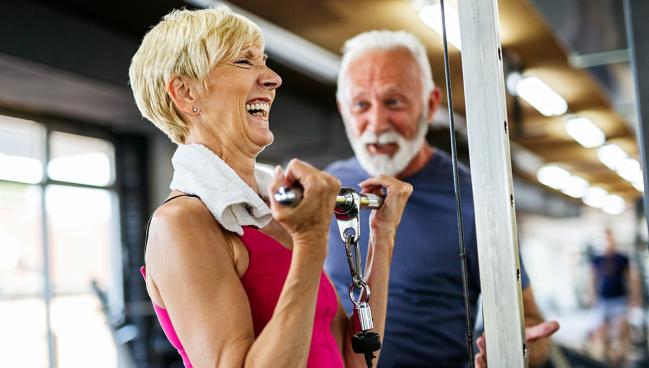Women Gain More From Exercise Than Men—and Get Away With Less
It may be time for the physical activity guidelines to consider giving sex-specific advice, senior author Susan Cheng says.

When it comes physical activity and exercise, women appear to get a lot more out of it than men, at least when it comes to risk reduction, according to new research published this week.
At equivalent doses of leisure-time physical activity, women have much larger reductions in all-cause and cardiovascular mortality, and they can achieve similar benefits as men with less time spent exercising, report Hongwei Ji, MD (Beijing Tsinghua Changgung Hospital, China), and colleagues this week in the Journal of the American College of Cardiology.
“In many ways, I think this lets women off the hook a little bit,” senior investigator Susan Cheng, MD (Smidt Heart Institute/Cedars-Sinai Medical Center, Los Angeles, CA), told TCTMD. “They may carry a lot of burden, and I'm totally generalizing here, in terms of responsibilities at work or responsibilities at home—the traditionally very busy woman in the household who doesn't feel like she has time to do anything. We’re saying you can get away with less: you can get more out of less. You don't have to feel like you have to keep up with your male counterparts and exercise 5 hours per week. You can get away with two-and-a-half hours.”
The findings are important as they challenge the “once-size-fits-all” approach currently used to prescribe physical activity to the general population, say investigators.
“It’s a lot for a clinician, never mind a patient, to keep track of what they should be drinking, what they should be eating, and how much exercise they should be getting,” said Cheng. “It's much easier to have a blanket statement. In many instances, it applies and it's appropriate. On the other hand, we’re living in a paradoxical age of biomedicine where we recognize that we really do want to personalize medicine down to each individual patient.”
While the days of writing a prescription for exercise and diet specifically tailored to the individual are years away yet, “we have to start with, at least at a basic level, the first order of difference and that is female versus male,” said Cheng.
Carl Lavie, MD (John Ochsner Heart and Vascular Institute, New Orleans, LA), who wasn’t involved in the study, has previously published data showing that women are much less likely than men to engage in leisure-time physical activity, with the largest sex disparities seen in the young and elderly, in Black and Hispanic individuals, and in those with lower incomes.
“Women seem to get substantial benefits at lower levels of exercise, which is a good message, but continue to get even more benefits at higher levels,” he told TCTMD in an email. “So even at levels below the guidelines, women are getting substantial benefits, which hopefully can stimulate them to be more active since generally their physical activity is less.”
He noted that while women tend to get a larger reduction in risk with the same amount of exercise, men tend to be at higher risk for cardiovascular disease, so it’s possible that the absolute benefit could be greater in higher-risk men.
Bigger Benefits Across the Board
The current US and European clinical guidelines recommend 150 to 300 minutes of moderate-intensity physical activity or 75 to 150 minutes of vigorous physical activity each week for health benefits, including a reduction in the risk of coronary heart disease. In the US, the physical activity guidelines from the Office of Disease Prevention and Health Promotion say it’s best to spread that activity out throughout the week and to add in muscle-strengthening activities of all major muscle groups at least 2 days per week.
The guidelines don’t differentiate by sex, though, instead recommending that men and women do the same amount of physical activity. However, as the investigators point out, it’s been well documented that males tend to have greater exercise capacity than females across all age groups, which may be the result of larger hearts, wider lung airways, and larger muscle fibers, among other differences.
“In physiology labs, we know that males and females perform differently,” she said. “So, it started to make sense when we thought about the study design of this particular paper that we might see something different.”
The study, which uses data from the Centers for Disease Control and Prevention’s National Center for Health Statistics, included 412,413 participants (mean age 43.9 years; 54.7% women). With nearly 5 million person-years of follow-up, there were 39,935 deaths from all causes and 11,670 cardiovascular deaths. Overall, 32.5% of women and 43.1% engaged in regular aerobic exercise, which was defined as meeting or exceeding the 150 weekly minutes of moderate-to-vigorous physical activity (MVPA) each week.
We’re saying you can get away with less, you can get more out of less. Susan Cheng
In women, regular physical activity compared with inactivity was associated with a 24% lower risk of all-cause mortality, whereas regularly active men had just a 15% reduction compared with inactive men (P < 0.001 for interaction by sex). Regular aerobic exercise versus inactivity decreased the risk of cardiovascular mortality by 14% in men compared with 36% in a similar comparison in women (P < 0.001 for interaction).
The greatest reduction in all-cause mortality in men was seen at 300 min/week of MVPA, an 18% reduction. With women, a similar reduction in all-cause mortality was seen at just 140 minutes of activity per week, but they made further gains with more exercise. For example, at roughly 300 minutes/week of MVPA, there was a 24% reduction in all-cause mortality risk in women. With vigorous physical activity (VPA), the largest benefit in men was seen at 110 minutes week, a 19% lower risk of all-cause mortality. Women achieved a similar reduction at only 57 minutes per week (P = 0.004 for interaction), with a maximum 24% reduction in all-cause mortality in women observed at 110 minutes of VPA each week.
Overall, the survival benefit was consistently higher in women than men when analyzed by exercise frequency, duration per session, and intensity, say researchers.
Additionally, they found that men who regularly hit the gym had an 11% reduction in all-cause mortality compared with those who didn’t do strength training. In women, the mortality risk reduction with strength training was 19% compared with women who didn’t work out (P = 0.005 for interaction).
Personalized Exercise Prescription
To TCTMD, Cheng said the magnitude of difference between men and women surprised the researchers, noting they had expected to see a much smaller gap. She acknowledged the potential for confounding, noting that physical activity is self-reported. Additionally, the confidence intervals are wide, “meaning there’s a lot of variation within men and within women,” she said.
Still, Cheng suspects it may be time for the physical activity guidelines to consider adopting different recommendations for men and women.
“If anything, I think, when counseling and advising your female as well as male patients, consider that the differences are likely to be quite real,” she said. “You can potentially temper some of your advice to your female patients about how hard and how much they really need to do to get a benefit. At the end of the day, anything is better than nothing, and more is better than less.”
In an editorial, Wael Jaber, MD, and Erika Hutt, MD (both from Cleveland Clinic, OH), agree that the sex-specific benefit seen in the present study could influence exercise recommendations in major guidelines. It might also encourage more women to engage in physical activity, particularly since the weekly goal is more achievable for those who struggle to find time.
They expand their lens, too, noting that healthcare providers need to push for policies that will reintroduce more casual physical activity into daily routines. In doing so, women would be expected “to reap the most benefits in terms of survival,” Jaber and Hutt write.
Michael O’Riordan is the Managing Editor for TCTMD. He completed his undergraduate degrees at Queen’s University in Kingston, ON, and…
Read Full BioSources
Ji H, Gulati M, Huang TY, et al. Sex differences in association of physical activity with all-cause and cardiovascular mortality. J Am Coll Cardiol. 2023;83:783-793.
Jaber WA, Hutt E. Sex-specific mortality benefits related to exercise. J Am Coll Cardiol. 2023;83:794-796.
Disclosures
- The authors report no relevant conflicts of interest.





Comments